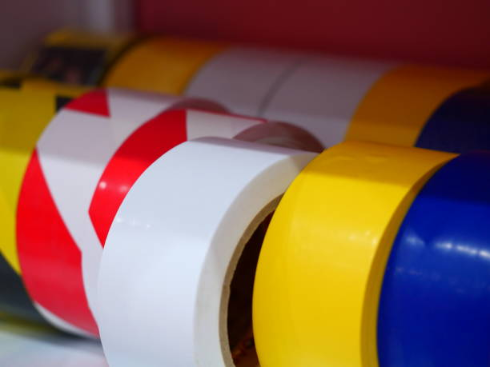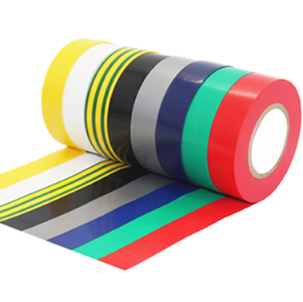
Picking electrical tape looks easy at first. You stroll into a store and see rolls of black, red, yellow, and green tapes lined up nicely. But when you start working on wires at home or in a factory, you notice not every tape is the same. Things like thickness, voltage strength, and how tape handles heat or chemicals really matter.
This guide explains how to choose the best electrical tape for different places. We’ll cover what’s important, when a simple tape works fine, and when you need a special one.
Why Electrical Tape Matters More Than You Think
You might think electrical tape is just sticky stuff. But when you’re fixing a live wire or shielding cables in a hot engine area, tape becomes a key guard against sparks, shocks, and fires.
At home: A bare wire behind a plug can start a spark. In factories: Wires in a warehouse face shaking and dust all the time. In cars: Heat from the engine pushes tape to its limit.
In each case, the wrong tape doesn’t just break, it can cause danger.
Key Factors to Consider
Thickness and Durability
Tape thickness affects how bendy and tough it is. Thin tapes (around 100μm) stretch easily around tight spots. Thicker ones (up to 180μm) give stronger protection.
| Product Code | Thickness (μm) | Tensile Strength | Voltage Rating | Service Temp |
| QKD-6025 | 100 | 13N/cm | 5KV | -10°C to 80°C |
| QKD-6060 | 190 | 14Mpa | 7KV | -10°C to 80°C |
| IE6#T | 150 | 20N/cm | 6KV | -10°C to 80°C |
| IE8#T | 180 | 22N/cm | 6KV | -10°C to 80°C |
Observation: For home wiring, a 100μm tape usually works well. But for factories, thicker tapes like IE6#T or IE8#T are better because they handle wear and tear.
Voltage Rating
People often forget about voltage strength. A 5KV tape sounds great, but some factory machines create stronger surges. So, you need extra protection.
- 5KV tape: Good for small home fixes, like outlets or lamps.
- 6KV tape: Often picked for medium factory settings.
- 7KV tape: Safer for heavy wiring or power systems.
It’s smart to choose a tape with a bit more voltage strength than you think you need.
Temperature Resistance
Most electrical tapes, like those from QKD Tape, work between -10°C and 80°C. This is fine for indoor jobs. But garages in summer or car engines can get really hot. If your project involves high heat, you might need to double up on tape or use it with protective sleeves.
Adhesion and Residue
Nobody wants to peel back wires and find gooey mess. Good PVC tapes stick well but don’t leave sticky stuff behind. This is important for electricians who open panels often. Cleaning sticky wires is annoying and not safe.

Matching Tape to Real Scenarios
1. Household Repairs
For fixing a lamp cord or tidying wires behind a TV, you need:
- Thickness: 100μm
- Voltage: 5KV
- Stretchy tape for small wires
The QKD-6025 is a great choice here. It insulates well and is easy to use.
2. Automotive Wiring
In cars, tape faces two problems: shaking and heat. A tape with stronger pull, like IE6#T or IE8#T, works better. Their extra thickness stops wear where wires rub against metal.
3. Industrial Applications
Factories have bigger power loads and tough conditions like dust, oil, or water. Tapes like QKD-6060 with a 7KV rating give extra safety. They’re thicker, harder to rip, and keep insulating even in wet conditions.
The Role of Color Coding
Electrical tape isn’t just for covering wires. Colors help with organizing.
- Black: General covering
- Red/Yellow/Blue: Marks different power phases
- Green/Yellow Stripe: Shows grounding wires
Using colors makes repairs faster. Electricians can quickly see which wire does what.
About QKD Tape
QKD Tape is a smart company that makes strong adhesive products. They offer everything from PVC electrical insulation tape to PET cloth wire harness tape and double sided foam tapes. Their focus on quality and new ideas makes their products trusted for homes, cars, and factories. If you need something unique, QKD also offers custom options.
Other Products to Electrical Work
- PET Tape: Great for bundling car wiring.
- Double Sided Acrylic Foam Tape: Useful for damping shakes and sticking things tightly.
- Wave Edge Double Sided Tissue Tape: Handy for electronics where you need exact sticking.
These tapes work alongside PVC insulation tape for bigger projects, offering special fixes when covering alone isn’t enough.
Conclusion
Picking the right electrical tape isn’t about grabbing any roll. It’s about matching the tape to your job. Think about thickness for toughness, voltage rating for safety, and heat resistance for the setting. A little care now saves time, money, and keeps things safe later.
QKD Tape keeps making products that fit these needs for homes, cars, and factories. Whether you’re an electrician wiring a big floor or a homeowner patching a cord, the right tape makes the job neater, safer, and lasts longer.
FAQs
Q1: How do I know if I’m using the right electrical tape at home?
For basic home wiring, like lamps or outlets, a 100μm tape rated at 5KV is enough. Just check that the temperature range fits your space.
Q2: Can I use the same electrical tape for home and industrial use?
You could, but it’s not the best idea. Factory work needs tougher tapes with higher voltage ratings. That’s where QKD-6060 stands out.
Q3: What’s the difference between 5KV and 7KV tape?
Higher voltage ratings mean better protection under pressure. A 7KV tape like QKD-6060 is safer for heavy jobs.
Q4: Does thickness really matter when choosing electrical tape?
Yes. Thicker tapes insulate better and resist wear. For example, IE8#T at 180μm is much stronger than thinner home tapes.
Q5: How to choose the right electrical tape for home and industrial use if I’m not sure about my needs?
Check the voltage and setting first. For homes, use lighter tapes. For factories, go for higher voltage and thicker builds. If you’re unsure, ask an electrician or check QKD’s products for options that fit different jobs.
